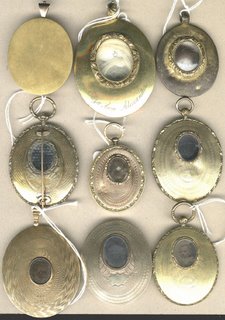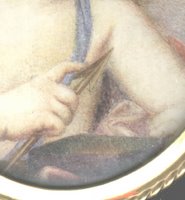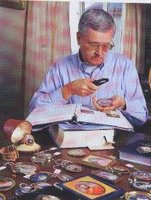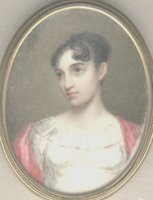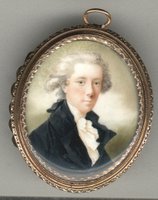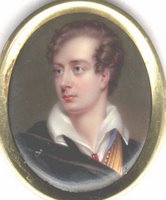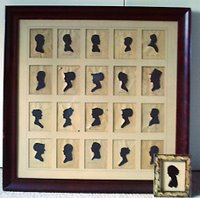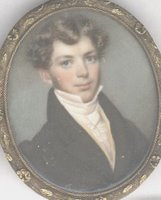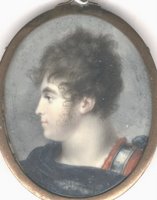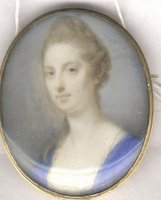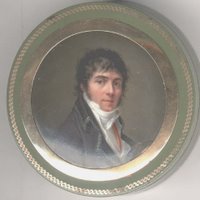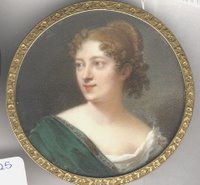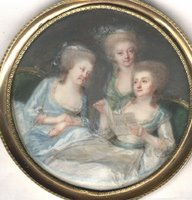

There are many useful books and as with any specialist collection, good reference books can pay for themselves many times over. The prime reference used here for ready reference is Blattel and thus a great deal of thanks needs to be awarded to Harry Blattel and also the other authors mentioned below who have put a great deal of time and effort into the subject.
For such a specialist subject, it is surprising how many books have been published. There are over 150 books in the reference section of the collection. They include the two early books illustrated here.
1 "L'Ecole de la Mignature etc." 180 pp. - this is the New Edition which was published in 1782. The first edition appears to have been published in 1778. It is interesting that the title refers to "mignature", rather than "miniature".
2 "Manuel de Miniature etc." 360 pp. - this is a rare first edition which was published in 1828.
The bibliography below is split geographically by where each book was published, but there is some cross-over of content. For example the American section concentrates on miniatures with an American focus, but also lists collections of British and European miniatures that are housed in America. Almost all of these books form part of the collection. In addition there is a quantity of auction house catalogues.
American Miniature PortraitsA Deaf Artist in Early America: The Worlds of John Brewster Jr., by Harlan Lane, 2004
After the Revolution: Profiles of Early American Culture by Joseph J. Ellis
A Gallery Collects Peales, by Robert Devlin Schwarz 1987
A History of the Rise and Progress of the Arts of Design in the United States, by William Dunlap, 1934
Alvan Clark & Sons – Artists in Optics, by Deborah Jean Warner and Robert B Ariail 1996
American Miniature Portraits on Ivory from the Collection of Linda and Raymond White, Huntsville Museum of Art 1996
American Painting, History and Interpretation, by Virgil Barker, 1950
American Pioneer Art & Artists, by Carl W. Drepperd 1942
American Portrait Miniatures in the Manney Collection by Dale T. Johnson 1990
American Portrait Miniatures: The Worcester Art Museum Collection by Susan E. Strickler 1989
American Miniatures: Metropolitan Museum of Art 1730-1850 by Harry B. Wehle 1927
American Wax Portraits, by Ethel Stanwood Bolton 1929
Anson Dickinson, The Celebrated Miniature Painter, 1779-1852, by Mona Leithiser Dearborn 1983
An Exhibition of Virginia Miniatures, Virginia Museum of Fine Arts 1941
A Perfect Likeness: European and American Portrait Miniatures from the Cincinnati Art Museum, by Julie Aronson and Marjorie E. Wieseman 2006
Artists In The Life of Charleston: Through Colony and State, from Restoration to Reconstruction, by Anna Wells Rutledge
Catalogue of American Portraits in the New York Historical Society, 1941
Catalogue of an Exhibition of Miniatures Painted in America 1729-1850, Metropolitan Museum of Art 1927
Catalogue of the Annual Water Color and Miniature Exhibitions, PAFA various years
Charles Fraser, by Alice R. Huger Smith and D. E. Huger Smith 1924
Charles Fraser of Charleston, ed by Martha Severens 1983
Early American Portrait Painters in Miniature, by Theodore Bolton, 1921
Elkanah Tisdale in The Connecticut Historical Bulletin Spring 1984
English and Continental Portrait Miniatures – the Latter-Schlesinger Collection by Pamela Pierrepont Bardo 1978
Ethel Frances Mundy (1876-1964), by Anna Wetherill Olmsted undated
European Miniatures in the Metropolitan Museum of Art, by Graham Reynolds 1997
Ezra Ames of Albany: Portrait Painter, Craftsman, Royal Arch Mason, Banker, 1768-1836, by Theodore Bolton and Irwin Cortelyou, New York, 1955
Four Centuries of Miniature Painting, Baltimore Museum of Art 1958
From Turnbridge, Vermont to London, England: The Journal of James Guild, Peddler, Tinker, Schoolmaster, Portrait Painter from 1818-1824, by James Guild
George Freeman, Miniaturist, by Wilma Keyes, Storrs CT, 1980
Heirlooms in Miniatures by Anne Hollingsworth Wharton 1898
Henry Benbridge (1743-1812) American Portrait Painter, by Robert G. Stewart 1971
Henry Benbridge (1743-1812): Charleston Portrait Painter, by Angela D. Mack
Jacob Frymire – American Limner, by Linda Crocker Simmons 1975
James Sandford Ellsworth – Portrait Painter, by Lucy B. Mitchell 1974
John Wesley Jarvis: American Painter by Harold E Dickson 1949
John Wesley Jarvis: An Account of His Life and the First Catalogue of His Work, by Theodore Bolton
John Wood Dodge in Tennessee Historical Quarterly by Raymond D White Spring 2000
Joseph-Pierre Picot de Limoelan de Clorivere in Journal of Southern Decorative Arts Winter 2002
Jouett-Bush-Frazer: Early Kentucky Artists, by William Barrow Floyd
Limners and Likenesses, by Alan Burroughs, 1965
Looking For Eulabee Dix, by Jo Ann Ridley 1997
Love and Loss: American Portrait and Mourning Miniatures by Robin Jaffee Frank 2000
Miniatures and Silhouettes of Early American Jews, by Hannah R. London 1970
National Miniature Exhibition Graphic Arts Pavillion 1933
New England Miniatures: 1750-1850, Museum of Fine Arts, Boston, compiled and edited by Barbara Neville Parker 1957
New York Historical Society's Dictionary of Artists in America 1564-1860 by George Groce and David Wallace
Painting and Portrait Making in the American Northeast, Peter Benes, Editor, by Boston Univeristy, 1994
Painting in the South: 1563-1980, Virginia Museum, Richmond
Paintings and Miniatures at the Historical Society of Pennsylvania by Nicholas B. Wainwright 1974
Paintings from Europe and the Americas in the Philadelphia Museum of Art 1994
Portraits and Miniatures by Charles Willson Peale, by Charles Coleman Sellers 1951
Portrait Miniatures from the Montreal Museum of Fine Arts, by Rosalind M. Pepall 1989
Portrait Miniatures in Early American History: 1750-1840, R.W. Norton Art Gallery, 1976
Portrait Miniatures in the National Museum of American Art, by Robin Bolton-Smith 1984
Portrait Miniatures in the Royal Ontario Museum, by H. Hickl-Szabo 1981
Portrait Miniatures on Ivory 1750-1850: From the Collection of The Connecticut Historical Society, by Philip Dunbar October 1964
Portrait Miniatures – The Edward H Greene Collection Cleveland Museum of Art 1951
Portrait Painting in America, The Nineteenth Century, Ellen Miles, Editor, 1977
Portraits in Miniature, by Maymie Eschwey 1988
Portraits in the Collection of the American Antiquarian Society, by Lauren B. Hewes 2004
Portraits in the Massachusetts Historical Society, by Andrew Oliver et al 1988
Robert Field: Portrait Painter in Oils, Miniature and Water-Colours and Engraver, by Harry Piers, New York, 1927
Robert Field, Art Gallery of Nova Scotia 1978
Saint Memin – Watercolor Miniatures, by J Hall Pleasants 1947
Saint Memin and the Neoclassical Profile Portrait in America, by Ellen G Miles 1994
St. Memin in Maryland, Maryland Historical Society 1951
Salons Colonial and Republican, by Anne Hollingsworth Wharton 1900
Samuel P Howes – Portrait Painter, Whistler House Museum 1986
Shades of Our Ancestors: American Profiles and Profilists, by Alice Van Leer Carrick
Social Life in the Early Republic, by Anne Hollingsworth Wharton 1902
The Art of Henry Inman, by William H Gerdts and Carrie Rebora 1987
The Beardsley Limner and some Contemporaries, by Christine Skeeles Schloss 1973
The Life and Works of Edward Green Malbone 1777-1807, by Ruel Pardee Tolman, New York, 1958
The Miniature Portrait Collection of the Carolina Art Association by Martha R. Severns 1984
The Miniatures of David Boudon, by Nancy E. Richards in Winterthur Portfolio 9 1974
The Peale Family, Lillian B. Miller 1996
The Peter Marie Collection by Viola Hopkins Winner in NYHS Journal Spring 2006
The Spanish Golden Age in Miniature Rosenbach Museum 1988
The Starr Collection of Miniatures, by Graham Reynolds 1971
Wax Portraits and Silhouettes, by Ethel Stanwood Bolton 1914
William Birch by J L Brockway in Glass on Metal 1996
William Russell Birch by William Russell Birch in Glass on Metal 1996
British Miniature Portraits300 Years of the English Miniature Illustrated from the Collections of the National Portrait Gallery, Richard Walker, London, 1998
A Biographical Dictionary of Wax Modellers, by E J Pyke 1973
A Dictionary of British Miniature Painters, by Daphne Foskett 1972
A Dictionary of Painters of Miniatures, by J.J. Foster, London, 1926
Andrew & Nathaniel Plimmer Miniature Painters by Geo C Williamson 1903
A Picture Book of English Miniatures, Victoria & Albert Museum 1929
Andrew Robertson, Letters and Papers of Andrew Robertson, by Emily Robertson, ed. 1879
Anecdotes of Painting in England, by Horace Walpole
Artists of the Tudor Court by Roy Strong 1983
A Thing Apart, The W R Johnston Collection by Roger and Carmela Arturi Phillips 2006
British Miniaturists, by Basil Long, 1929
British Portrait Miniatures, by Daphne Foskett 1963
British Portrait Miniatures, Edinburgh Exhibition 1965
British Portrait Miniatures, by Graham Reynolds 1997
British Profile Miniaturists, by Arthur Mayne 1970
Catalogue for the Sale of the J Pierpont Morgan Collection, Christie’s 1935
Catalogue of a Collection of Miniatures Belonging to Lord Hothfield, by Geo. C. Williamson 1916
Catalogue of Portrait Miniatures : In the Fitzwilliam Museum, Cambridge (Fitzwilliam Museum Publications), by Robert Bayne-Powell 1985
Catalogue of the Special Exhibition of Portrait Miniatures on Loan at the South Kensington Museum, June 1865 Chats on Old Miniatures, by J. J. Foster 1908
Collecting Miniatures by Daphne Foskett 1979
Collecting Old Miniatures by J H Yoxall 1916
Commoners and Me, by Gertrude Massey, 1934
Dictionary of British Art, by C. Wood
Dictionary of British Portrait Painters, by Stewart and Cutten
Elizabethan Miniatures, by Carl Winter, 1952
English Miniatures Diary V&A 1989
English Portrait Miniatures, by Graham Reynolds 1952
European Miniatures in the Metropolitan Museum of Art, by Graham Reynolds 1997
Fitzwilliam Museum Handbooks: British Portrait Miniatures, by Graham Reynolds 1998
George Engleheart 1750-1829, Miniature Painter to George III, by Geo C Williamson, 1902
Hilliard & Oliver by Mary Edmond 1983
History of Miniature Art, by Lumsden Propert, London 1887
Hanging the Head : Portraiture and Social Formation in Eighteenth-Century England, by Marcia Pointon Kings
How to Identify Portrait Miniatures, by Geo C Williamson 1909
India and British Portraiture, 1770-1825, by Mildred Archer, 1979
John Comerford and The Portrait Miniature in Ireland, Paul Caffrey
John Smart, the Man and his Miniatures, by Daphne Foskett, 1964
Life and Works of Ozias Humphry, R.A. by George C. Williamson, London 1918
Masterpieces in Little : Portrait Miniatures from the Collection of Her Majesty Queen Elizabeth II, by Christopher Lloyd and Vanessa Remington 1997
Masterpieces of Miniature Painting, by Ernest Lemberger and Franz Hanfstaengl
Miniature Painters British and Foreign With Some Account of Those Who Practiced in America in the Eighteenth Century, by J.J. Foster 1903
Miniatures by Cyril Davenport 1908
Miniatures - a Selection from the Ashmolean Museum by Richard Walker 1997
Miniatures Address Book V&A 1990
Miniatures and Silhouettes, by Max von Bohen 1928
Miniatures at Kenwood: The Draper Gift, by Julius Bryant 1997
Miniatures Diary 1991 V&A
Miniatures Dictionary and Guide, by Daphne Foskett 1987
Miniatures in the XVIII & XIX Centuries, by Donough O’Brien 1951
Miniatures in the Collection of Her Majesty The Queen : The Eighteenth and Nineteenth Centuries (Catalogue of Miniatures in the Collection of H M The Queen) by Richard Walker 1992
Nicholas Hilliard by Roy Strong 1975
Painting Miniatures by Elizabeth Davys Wood 1989
Portrait Miniatures by Geo C Williamson 1897
Portrait Miniatures in The Studio by Geo C Williamson 1910
Portrait Miniatures Victoria & Albert Museum 1959
Portrait Miniatures by Stephen Butler 1994
Portrait Miniatures from the Clarke Collection, by Stephen Lloyd 2001
Portrait Miniatures from the Collection of the Duke of Buccleuch by Stephen Lloyd 1996
Portrait Miniatures from the Daphne Foskett Collection, by Stephen Lloyd 2003
Portrait Miniatures from the Dumas Egerton Collection by Stephen Lloyd 2002
Portrait Miniatures from the Merchiston Collection, by Stephen Lloyd 2005
Portrait Miniatures from the National Gallery of Scotland, by Stephen Lloyd 2004
Portrait Miniatures in Enamel: The Gilbert Collection, by Sarah Coffin and Bodo Hofstetter 2000
Portrait Miniatures in National Trust Houses - Vol 1 by Richard Walker & Alastair Laing 2003
Portrait Miniatures in National Trust Houses - Vol 2 by Richard Walker & Alastair Laing 2005
Richard and Maria Cosway, Regency Artists of Taste and Fashion, by Stephen Lloyd et al, 1995
Royal Portraits Diary 1991 V&A
Samuel Cooper (1608-1672) by Daphne Foskett 1974
Secret Passion to Noble Fashion: The World of the Portrait Miniature, by Ann Summer and Richard Walker 1999
Sir William Newton by Linda Goforth Zillman 1986
The Art of Limning by Nicholas Hilliard 1992
The Art of the Miniature Painter by Geo C Williamson 1926
The Art of Miniature Painting by C W Day undated
The British Miniature by Raymond Lister 1951
The English Miniature by John Murdoch, Jim Murrell, Patrick J. Noon & Roy Strong 1981
The English Renaissance Miniature by Roy Strong 1983
The Guide to Miniature Painting and Colouring Photographs by J S Templeton undated
The Miniature Collector: A Guide to Collectors of Old Portrait Miniatures, by Geo C Williamson, 1921
The Portrait Miniature in England by Katherine Coombs 1998
The Princess Charlotte of Wales, by Mrs Herbert Jones 1885
The Sixteenth and Seventeenth-Century Miniatures: In the Collection of Her Majesty the Queen (Royal Collection) by Graham Reynolds 1999
The Techniques of Painting Miniatures by Sue Burton 1995
The Wallace Collection: Catalogue of Miniatures by Graham Reynolds 1980
The Way Howe to Lymme by Jim Murrell 1983
Treasures to Hold: Irish and English Miniatures 1650-1850 from the National Gallery of Ireland by Paul Caffrey, Jane Macavock, and Adrian Le Harivel 2000
Two Centuries of Silhouettes by Peggy Hickman 1971
Wallace Collection Catalogue by W P Gibson 1935
European Miniature Portraits100 Ans des Miniatures Suisse edited by Jeane-Claude Genoud, 1991
Aspects of Miniature Painting by Torben Holck Colding 1953
Capolavori in Smalto e Avorio Various 2004
Chefs-D'oeuvre de la Miniature et de la Gouache Musee Geneve 1956
Cornelius Hoyer by Torben Holck Colding 1961
Die Miniaturen der Albertina in Wien by Nora Keil 1977
Giambattista Gigola 1767-1841 by Bernado Falconi et al 2001
Historie de la Miniature Feminine Francaise by Camille Mauclair 1925
International Dictionary of Miniature Painters, by Harry Blattel 1992
Inventaire des Miniatures Sur Ivoire: Musee du Louvre, Musee D'Orsay by Pierrette Jean-Richard 1994
La Miniature sur Ivoire, Essai Historique et Traite Pratique by Mme. G. Debillemot-Chardon, 1910
Les Miniatures, Musee Cognaqu-Jay, Paris by Nathalie Lemoine-Bouchard 2002
Les Peintres en Miniature Actifs en France 1650-1850 by Nathalie Lemoine-Bouchard 2008
Miniaturen aus der Sammlung Tansey by Dietrun Otten and Bernd Pappe 2000
Miniaturen der Revolutionszeit 1789-1799 Aus Sammlung Tansey by Bernd Pappe et al 2005
Miniaturen des 19 Jahrhunderts aus der Sammlung Tansey by Bernd Pappe et al 2002
Miniaturen des Rokoko, Empire und Biedermeier by Heinz E R Martin 1981
Miniaturen-Dosen, Battenberg Antiquitäten Kataloge by Jörg Nimmergut 1982
Miniaturen und Silhouetten by Max von Boehn 1917
Miniatures in the State Pushkin Museum St Petersburg by Eugenia Ivanova 1996
Nationalmuseum Stockholm, Illustrated Catalogue, 2 Volumes by Magnus Olausson, 2001
Pierre Adolphe Hall 1739-1793 by Regine de Plinval de Guillebon
Portraitminiatures des Hauses Habsburg by Robert Keil 1999
Portrait Miniatures from the Collection of the Russian Museum by K V Mikhailova and G V Smirnov 1974
Portrait Miniatures in the Collection of the State Pushkin Museum Moscow by Lydia Karnaukhova 1997
Portrait Miniature in Russia XVIII-early XX Century from the Hermiage Collection by G N Komelova and G A Printseva 1986
Portrait Miniature in Russia XVIII-XIX Centuries Historical Museum Moscowby T A Selinova 1988
Portraits des Maisons Royales et Imperiales de France et d'Europe by Nicole Garnier-Pelle, Nathalie Lemoine-Bouchard, and Bernd Pappe
The Miniature in Europe in The 16th, 17th, 18th, and 19th Centuries by Leo R. Schidlof 1964
The Portrait Miniatures in the Collections of the House of Orange-Nassau by Karen Schaffers-Bodenhausen 1993
Online ArticlesFrom Hand to Heart: The Art of the American Miniature Portrait by Peter J. Baldaia
Object Lessons: Miniature Worlds by Catherine KellySelf-Fashioning in Sarah Goodridge’s Self-Portraits by Chris PackardThe Legacy of Nathaniel Rogers (1787-1844), by Natalie A. NaylorJohn Wood Dodge and the Portrait Miniature, The Magazine Antiques, November 2003, by Raymond WhiteThe Art of John Henry Brown, The Magazine Antiques, November 2004, by Anne VerplanckPortraits in Miniature: Anna Claypoole Peale and Caroline Schetky, The Magazine Antiques, February 2002, by Anne Sue HirshornMoses B. Russell: Yankee Miniaturist, The Magazine Antiques, November 2002 , by Randall L. Holton, Charles A. GildayThe Portrait Miniatures of Eulabee Dix: Watercolor Painter, The Magazine Antiques, November 1994, by Anne Sue HirshornJohn O'Brien Inman: American Artist, The Magazine Antiques, November 1998, by Carolyn B. WilkinsonMrs. Moses B. Russell, Boston Miniaturist: Bibliography, The Magazine Antiques, December 1999, by Randall L. Holton, Charles A. GildayAn Art in Living: Lucy May Stanton, by Betty Alice FowlerDismissed Yet Disarming: The Portrait Miniature Revival, 1890-1930, Maryann Sudnick Gunderson, November 2003Other Reference BooksFashions in Hair by Richard Corson 1995
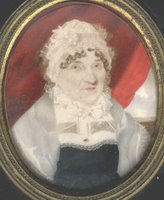
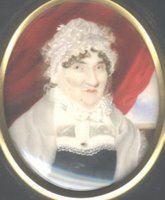 These are where the original artist made several identical copies of a miniature, for example for different members of a family.
These are where the original artist made several identical copies of a miniature, for example for different members of a family. Even in this category of copies, there are some very expensive miniatures. In the 18C and 19C some very famous artists, such as Henry Bone and his son Henry Pierce Bone, painted very fine miniature copies on enamel of large portraits and these now sell for very high prices.
Even in this category of copies, there are some very expensive miniatures. In the 18C and 19C some very famous artists, such as Henry Bone and his son Henry Pierce Bone, painted very fine miniature copies on enamel of large portraits and these now sell for very high prices.

 The original painted in 1797 and a shown here, is in the State Russian Museum of Fine Arts in Moscow and is attributed to Miles. It looks identical to the version in this collection, apart from the style of the frame.
The original painted in 1797 and a shown here, is in the State Russian Museum of Fine Arts in Moscow and is attributed to Miles. It looks identical to the version in this collection, apart from the style of the frame. Fakes and Decorative Copies
Fakes and Decorative Copies Decorative miniatures may have the purported signature of the original artist, be unsigned, or have a deliberately wrongly spelled name of a famous artist of an earlier period, such as Cobway for Cosway. Names like Stieler, Nattier, Cosway, Smart, and Isabey or variations upon their names are commonly found.
Decorative miniatures may have the purported signature of the original artist, be unsigned, or have a deliberately wrongly spelled name of a famous artist of an earlier period, such as Cobway for Cosway. Names like Stieler, Nattier, Cosway, Smart, and Isabey or variations upon their names are commonly found. Many have frames that when looked at, can be seen to have been made of old piano keys pieced together. Some have very ornate pierced frames.
Many have frames that when looked at, can be seen to have been made of old piano keys pieced together. Some have very ornate pierced frames.
 Decorative miniatures are still being painted and some of them are of a very high standard. Shown here are four Russian miniatures painted since 2000. They are of Tsar Nicholas II and his wife Alexandra, together with two of his children, Grand Duchess Tatania amd Grand Duchess Anastasia.
Decorative miniatures are still being painted and some of them are of a very high standard. Shown here are four Russian miniatures painted since 2000. They are of Tsar Nicholas II and his wife Alexandra, together with two of his children, Grand Duchess Tatania amd Grand Duchess Anastasia.
 Miniatures by Fedoskino artists can provide a means of forming an attractive and inexpensive collection, and in doing so provide an insight into the times and events associated with the originals.
Miniatures by Fedoskino artists can provide a means of forming an attractive and inexpensive collection, and in doing so provide an insight into the times and events associated with the originals.


